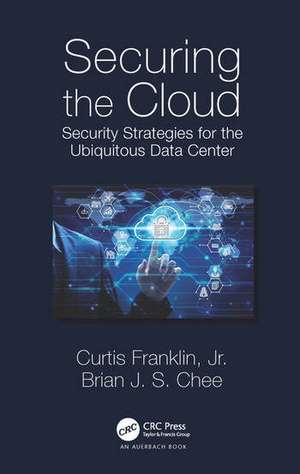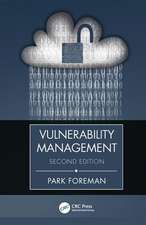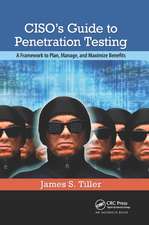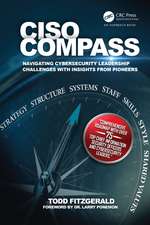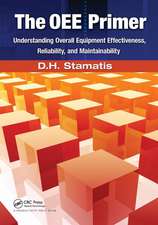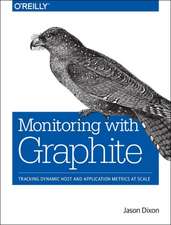Securing the Cloud: Security Strategies for the Ubiquitous Data Center
Autor Curtis Franklin Jr., Brian Cheeen Limba Engleză Hardback – 2 apr 2019
Securing the Cloud: Security Strategies for the Ubiquitous Data Center takes the position that cloud security is an extension of recognized, established security principles into cloud-based deployments. It explores how those principles can be put into practice to protect cloud-based infrastructure and data, traditional infrastructure, and hybrid architectures combining cloud and on-premises infrastructure.
Cloud computing is evolving so rapidly that regulations and technology have not necessarily been able to keep pace. IT professionals are frequently left to force fit pre-existing solutions onto new infrastructure and architectures for which they may be very poor fits. This book looks at how those "square peg/round hole" solutions are implemented and explains ways in which the pegs, the holes, or both may be adjusted for a more perfect fit.
| Toate formatele și edițiile | Preț | Express |
|---|---|---|
| Paperback (1) | 246.92 lei 6-8 săpt. | |
| CRC Press – 21 ian 2023 | 246.92 lei 6-8 săpt. | |
| Hardback (1) | 481.88 lei 6-8 săpt. | |
| CRC Press – 2 apr 2019 | 481.88 lei 6-8 săpt. |
Preț: 481.88 lei
Preț vechi: 602.34 lei
-20% Nou
Puncte Express: 723
Preț estimativ în valută:
92.21€ • 100.47$ • 77.70£
92.21€ • 100.47$ • 77.70£
Carte tipărită la comandă
Livrare economică 23 aprilie-07 mai
Preluare comenzi: 021 569.72.76
Specificații
ISBN-13: 9781466569201
ISBN-10: 1466569204
Pagini: 254
Ilustrații: 50 Illustrations, black and white
Dimensiuni: 156 x 234 x 16 mm
Greutate: 0.62 kg
Ediția:1
Editura: CRC Press
Colecția Auerbach Publications
Locul publicării:Boca Raton, United States
ISBN-10: 1466569204
Pagini: 254
Ilustrații: 50 Illustrations, black and white
Dimensiuni: 156 x 234 x 16 mm
Greutate: 0.62 kg
Ediția:1
Editura: CRC Press
Colecția Auerbach Publications
Locul publicării:Boca Raton, United States
Public țintă
Professional Practice & DevelopmentCuprins
Dedication
Contents
Preface
Acknowledgments
About the Authors
Chapter 1 Introduction
Chapter 2 We Need a New Model for Security
Chapter 3 The Basics of IT Security: From Mainframe to Cloud
Chapter 4 The Basics of Security Failure
Chapter 5 The Basics of Fitting Security to Situation
Chapter 6 Defining the Cloud to Protect
Chapter 7 Infrastructure as a Service
Chapter 8 Platform as a Service (PaaS)
Chapter 9 Software as a Service
Chapter 10 Virtual Desktop Infrastructure
Chapter 11 Understand Your Cloud Type
Chapter 12 Public Cloud
Chapter 13 Private Cloud
Chapter 14 Hybrid Cloud
Chapter 15 Working with Your Cloud Provider
Chapter 16 Protecting the Perimeter
Chapter 17 Protecting the Contents
Chapter 18 Protecting the Infrastructure
Chapter 19 Tie the Cloud Using an Internal Management Framework
Chapter 20 Closing Comments
Index
Contents
Preface
Acknowledgments
About the Authors
Chapter 1 Introduction
Chapter 2 We Need a New Model for Security
Chapter 3 The Basics of IT Security: From Mainframe to Cloud
Chapter 4 The Basics of Security Failure
Chapter 5 The Basics of Fitting Security to Situation
Chapter 6 Defining the Cloud to Protect
Chapter 7 Infrastructure as a Service
Chapter 8 Platform as a Service (PaaS)
Chapter 9 Software as a Service
Chapter 10 Virtual Desktop Infrastructure
Chapter 11 Understand Your Cloud Type
Chapter 12 Public Cloud
Chapter 13 Private Cloud
Chapter 14 Hybrid Cloud
Chapter 15 Working with Your Cloud Provider
Chapter 16 Protecting the Perimeter
Chapter 17 Protecting the Contents
Chapter 18 Protecting the Infrastructure
Chapter 19 Tie the Cloud Using an Internal Management Framework
Chapter 20 Closing Comments
Index
Notă biografică
Curtis Franklin, Jr., is Senior Editor at Dark Reading. In addition, he works on audio and video programming for Dark Reading and contributes to activities at Interop™ ITX, Black Hat®, and other conferences. Curtis is also a co-host for the popular This Week in Enterprise Tech podcast. Curtis has been writing about technologies and products in computing and networking since the early 1980s. He has contributed to or been on staff at a number of technology-industry publications, including Information Week, Light Reading, Enterprise Efficiency, ChannelWeb, Network Computing, InfoWorld, PCWorld, Dark Reading, Circuit Cellar INK, BYTE, and ITWorld.com, on subjects ranging from mobile enterprise computing to enterprise security and wireless networking.
Curtis is the author of thousands of articles, the co-author of five books, and has been a frequent speaker at computer and networking industry conferences across North America and Europe. His most popular previous book, The Absolute Beginner’s Guide to Podcasting, with coauthor George Colombo, was published by Que Books (October 2005). His most recent book, Cloud Computing: Technologies and Strategies of the Ubiquitous Data Center, with co-author Brian Chee.
Brian J. S. Chee lives in Kaneohe, Hawaii, with his family tracing back four generations in Hawaii. An admitted generalist, starting with building IMSAI 8080s, writing assembler on punch cards for IBM 360s, and jumping into becoming one of the first 10 Novell Instructors outside of Novell, Inc. It was with the GSA Office of Information Security that he traveled the world working on secure data/video/voice communications systems for just about every three-letter agency in the book. Now, working as a researcher at the University of Hawaii School of Ocean and Earth Science and Technology (www.soest.hawaii.edu), he has gotten to work on underwater cabled observatories, autonomous underwater vehicles, SWATH ships, deep dive submarines and ROVs, volcanic sensors, and emerging energy systems. His greatest job was working with InteropNET NOC, where he became part of a team that has affected the majority of the standards of the Internet while creating methodologies for the interoperability of Internet communications systems.
Look for his publications at InfoWorld and podcasts for This Week in Enterprise Technology on the TWiT.tv network, as well as the aforementioned first book in this series, Cloud Computing: Technologies and Strategies of the Ubiquitous Data Center.
Curtis is the author of thousands of articles, the co-author of five books, and has been a frequent speaker at computer and networking industry conferences across North America and Europe. His most popular previous book, The Absolute Beginner’s Guide to Podcasting, with coauthor George Colombo, was published by Que Books (October 2005). His most recent book, Cloud Computing: Technologies and Strategies of the Ubiquitous Data Center, with co-author Brian Chee.
Brian J. S. Chee lives in Kaneohe, Hawaii, with his family tracing back four generations in Hawaii. An admitted generalist, starting with building IMSAI 8080s, writing assembler on punch cards for IBM 360s, and jumping into becoming one of the first 10 Novell Instructors outside of Novell, Inc. It was with the GSA Office of Information Security that he traveled the world working on secure data/video/voice communications systems for just about every three-letter agency in the book. Now, working as a researcher at the University of Hawaii School of Ocean and Earth Science and Technology (www.soest.hawaii.edu), he has gotten to work on underwater cabled observatories, autonomous underwater vehicles, SWATH ships, deep dive submarines and ROVs, volcanic sensors, and emerging energy systems. His greatest job was working with InteropNET NOC, where he became part of a team that has affected the majority of the standards of the Internet while creating methodologies for the interoperability of Internet communications systems.
Look for his publications at InfoWorld and podcasts for This Week in Enterprise Technology on the TWiT.tv network, as well as the aforementioned first book in this series, Cloud Computing: Technologies and Strategies of the Ubiquitous Data Center.
Descriere
This book present the principles of cloud computing security. From a definition of terms to key issues for service contracts, it's a must-have companion for anyone charged with protecting cloud-based assets or using cloud-based security to protect traditional computing assets.
